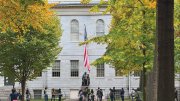One of the most consequential and beautiful medical books ever published, Andreas Vesalius’s De Humani Corporis Fabrica (“On the fabric of the human body”) revolutionized the science and the teaching of anatomy. With this encyclopedic account in 1543 of the structures and workings of the human bodyfrom the skeleton and muscles to the viscera and the brainVesalius corrected errors in the teachings of Greek physician Galen that had informed (and misinformed) medicine for 1,400 years. Because of religious scruples, Galen had dissected pigs, dogs, and Barbary apes; Vesalius pushed his own view, a radical one, that only through the study of human cadavers could physicians get a sufficiently detailed understanding of human anatomy. Moreover, he asserted, physicians ought to do hands-on dissecting themselves, not leave it to menials. In 1539 a judge in Padua, where Vesalius taught, had allowed autopsies of executed criminals, but these were always in short supply and included few women. Vesalius urged physicians to use their initiative in securing research material and was himself an unrepentant robber of graves.
 |
| Boston Medical Library in the Francis A. Countway Library of Medicine, Harvard Medical School |
Born in Brussels in 1514, he is described as of fiery temperament, vigorous, and indefatigable. Judging from the proportions of his body as shown in a portrait, he may have been somewhat dwarfed. He died in 1564 in a shipwreck. Vesalius had artistic sensibilities. He directed the typography of his 16-by-10 1/4-inch masterwork, printed in Basel, and took care that a plate and the relevant text appeared together. He oversaw the creation of the more than 200 woodblock engravings, cut in Venice and attributed to the school of Titian. Along with the contemplative fellow at left, these include 14 full-page muscle-men, who stand in landscapes that, seen together, form a panorama of the hills near Padua.
This is not a hugely rare book, says Jack Eckert, reference librarian at the Center for the History of Medicine in Harvard’s Countway Library of Medicine. A 1984 census of the Fabrica turned up 132 copies of the first edition. The Countway holds four of them, the one opened here in the Boston Medical Library collection. It has associations: the late Moseley professor of surgery Harvey Cushing, Vesalius’s bibliographer and biographer of medical educator Sir William Osler, pored over this volume, a gift in 1904 from Sir William himself.





